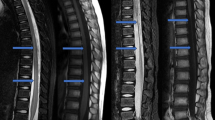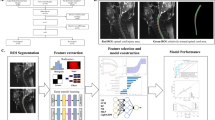Abstract
Study design:
Pictorial review.
Objectives:
To illustrate MRI signs of acute and subacute injury with emphasis on evidence-based links to clinical outcome and implications for treatment.
Methods:
Description of important aspects of MRI techniques and illustration of critical MRI signs important in the assessment of spinal cord injury following trauma, in the acute and subacute stages.
Conclusions:
Familiarity with cord MRI appearances has an important impact on planning the management of the acutely spinal cord injured patient and also identifying complications in the subacute phase particularly in the presence of neurological deterioration.
Similar content being viewed by others
Log in or create a free account to read this content
Gain free access to this article, as well as selected content from this journal and more on nature.com
or
References
Steeves JD, Lammertse D, Curt A, Fawcett JW, Tuszynski MH, Ditunno JF et al. Guidelines for the conduct of clinical trials for spinal cord injury (SCI) as developed by the ICCP panel: clinical trial outcome measures. Spinal Cord 2007; 45: 206–221.
Miyanji F, Furlan JC, Aarabi B, Arnold PM, Fehlings MG . Acute cervical traumatic spinal cord injury: MR imaging findings correlated with neurologic outcome--prospective study with 100 consecutive patients. Radiology 2007; 243: 820–827.
Tewari MK, Gifti DS, Singh P, Khosla VK, Mathuriya SN, Gupta SK et al. Diagnosis and prognostication of adult spinal cord injury without radiographic abnormality using magnetic resonance imaging: analysis of 40 patients. Surg Neurol 2005; 63: 204–209.
Flanders AE, Schaefer DM, Doan HT, Mishkin MM, Gonzalez CF, Northrup BE . Acute cervical spine trauma: correlation of MR imaging findings with degree of neurologic deficit. Radiology 1990; 177: 25–33.
Schaefer DM, Flanders A, Northrup BE, Doan HT, Osterholm JL . Magnetic resonance imaging of acute cervical spine trauma correlation with severity of neurologic injury. Spine 1989; 14: 1090–1095.
Green RA, Saifuddin A . Whole spine MRI in the assessment of acute vertebral body trauma. Skeletal Radiol 2004; 33: 129–135.
Lammertse D, Dungan D, Dreisbach J, Falci S, Flanders A, Marino R et al. Neuroimaging in traumatic spinal cord injury: an evidence-based review for clinical practice and research. J Spinal Cord Med 2007; 30: 205–214.
Bammer R, Fazekas F, Augustin M, Simbrunner J, Strasser-Fuchs S, Seifert T et al. Diffusion-weighted MR imaging of the spinal cord. Am J Neuroradiol 2000; 21: 587–591.
Bammer R, Fazekas F . Diffusion imaging of the human spinal cord and the vertebral column. Top Magn Reson Imaging 2003; 14: 461–476.
Raya JG, Dietrich O, Reiser MF, Baur-Melnyk A . Methods and applications of diffusion imaging of vertebral bone marrow. J Magn Reson Imaging 2006; 24: 1207–1220.
Quencer RM, Bunge RP . The injured spinal cord: imaging, histopathologic clinical correlates, and basic science approaches to enhancing neural function after spinal cord injury. Spine 1996; 21: 2064–2066.
Berens SA, Colvin DC, Yu CG, Yezierski RP, Mareci TH . Evaluation of the pathologic characteristics of excitotoxic spinal cord injury with MR imaging. Am J Neuroradiol 2005; 26: 1612–1622.
Ohshio I, Hatayama A, Kaneda K, Takahara M, Nagashima K . Correlation between histopathologic features and magnetic resonance images of spinal cord lesions. Spine 1993; 18: 1140–1149.
Shimada K, Tokioka T . Sequential MRI studies in patients with cervical cord injury but without bony injury. Paraplegia 1995; 33: 573–578.
Shimada K, Tokioka T . Sequential MR studies of cervical cord injury: correlation with neurological damage and clinical outcome. Spinal Cord 1999; 37: 410–415.
Fehlings MG, Rao SC, Tator CH, Skaf G, Arnold P, Benzel E et al. The optimal radiologic method for assessing spinal canal compromise and cord compression in patients with cervical spinal cord injury Part II: Results of a multicenter study. Spine 1999; 24: 605–613.
Fehlings MG, Furlan JC, Massicotte EM, Arnold P, Aarabi B, Harrop J et al. Interobserver and intraobserver reliability of maximum canal compromise and spinal cord compression for evaluation of acute traumatic cervical spinal cord injury. Spine 2006; 31: 1719–1725.
Leypold BG, Flanders AE, Burns AS . The early evolution of spinal cord lesions on MR imaging following traumatic spinal cord injury. Am J Neuroradiol 2008; 29: 1012–1016.
Kulkarni MV, McArdle CB, Kopanicky D, Miner M, Cotler HB, Lee KF et al. Acute spinal cord injury: MR imaging at 1.5T. Radiology 1987; 164: 837–843.
Boldin C, Raith J, Fankhauser F, Haunschmid C, Schwantzer G, Schweighofer F . Predicting neurologic recovery in cervical spinal cord injury with postoperative MR imaging. Spine 2006; 31: 554–559.
Silberstein M, Tress BM, Hennessy O . Prediction of neurologic outcome in acute spinal cord injury: the role of CT and MR. Am J Neuroradiol 1992; 13: 1597–1608.
Nedeltchev K, Loher TJ, Stepper F, Arnold M, Schroth G, Mattle HP et al. Long-term outcome of acute spinal cord ischaemia syndrome. Stroke 2004; 35: 560–565.
Loher TJ, Bassetti CL, Lovblad KO, Stepper FP, Sturzenegger M, Kiefer C et al. Diffusion-weighted MRI in acute spinal cord ischaemia. Neuroradiology 2003; 45: 557–561.
Fujikawa A, Tsuchiya K, Takeuchi S, Hachiya J . Diffusion-weighted MR imaging in acute spinal cord ischemia. Eur Radiol 2004; 14: 2076–2078.
Kuker W, Weller M, Klose U, Krapf H, Dichgans J, Nagele T . Diffusion-weighted MRI of spinal cord infarction--high resolution imaging and time course of diffusion abnormality. J Neurol 2004; 251: 818–824.
Thurnher MM, Bammer R . Diffusion-weighted MR imaging (DWI) in spinal cord ischemia. Neuroradiology 2006; 48: 795–801.
Gonzalez CM, Matheus G, Solander S, Castillo M . Transient edema of the spinal cord as a result of spontaneous acute epidural hematoma in the thoracic spine. Emerg Radiol 2004; 11: 53–55.
Planner AC, Pretorius PM, Graham A, Meagher TM . Subacute progressive ascending myelopathy following spinal cord injury: MRI appearances and clinical presentation. Spinal Cord 2008; 46: 140–144.
Frankel HL . Ascending cord lesion in the early stages following spinal injury. Paraplegia 1969; 7: 111–118.
Aito S, El Masry WS, Gerner HJ, Lorenzo ND, Pellicano G, D'Andrea M et al. Ascending myelopathy in the early stage of spinal cord injury. Spinal Cord 1999; 37: 617–623.
Schmidt BJ . Subacute delayed ascending myelopathy after low spine injury: case report and evidence of a vascular mechanism. Spinal Cord 2006; 44: 322–325.
Lee TT, Arias JM, Andrus HL, Quencer RM, Falcone SF, Green BA . Progressive posttraumatic myelomalacic myelopathy: treatment with untethering and expansive duraplasty. J Neurosurg 1997; 86: 624–628.
Wang D, Bodley R, Sett P, Gardner B, Frankel H . A clinical magnetic resonance imaging study of the traumatised spinal cord more than 20 years following injury. Paraplegia 1996; 34: 65–81.
Rossier AB, Foo D, Shillito J, Dyro FM . Posttraumatic cervical syringomyelia. Incidence, clinical presentation, electrophysiological studies, syrinx protein and results of conservative and operative treatment. Brain 1985; 108 : 439–461.
Author information
Authors and Affiliations
Corresponding author
Ethics declarations
Competing interests
The authors declare no conflict of interest.
Rights and permissions
About this article
Cite this article
Chandra, J., Sheerin, F., Lopez de Heredia, L. et al. MRI in acute and subacute post-traumatic spinal cord injury: pictorial review. Spinal Cord 50, 2–7 (2012). https://doi.org/10.1038/sc.2011.107
Received:
Revised:
Accepted:
Published:
Issue date:
DOI: https://doi.org/10.1038/sc.2011.107
Keywords
This article is cited by
-
Difficulties capturing co-occurring traumatic brain injury among people with traumatic spinal cord injury: a population-based study
Spinal Cord (2023)
-
Pharmacokinetics and anti-inflammatory effect of naproxen in rats with acute and subacute spinal cord injury
Naunyn-Schmiedeberg's Archives of Pharmacology (2020)
-
Clinical applicability of magnetic resonance imaging in acute spinal cord trauma
European Spine Journal (2013)



